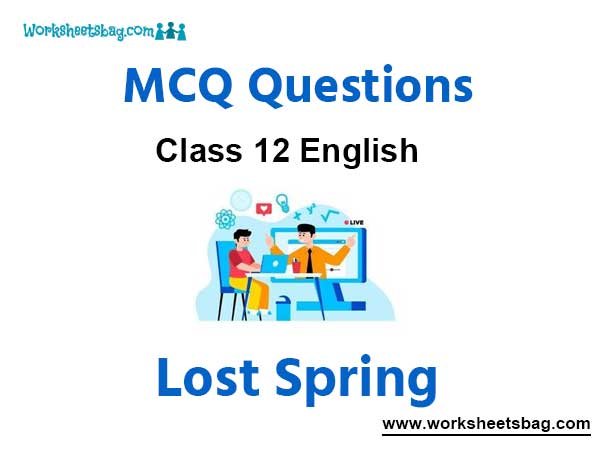Please refer to Lost Spring MCQ Questions Class 12 English below. These MCQ questions for Class 12 English with answers have been designed as per the latest NCERT, CBSE books and syllabus issued for the current academic year. These objective questions for Lost Spring will help you to prepare for the exams and get more marks.
Lost Spring MCQ Questions Class 12 English
Please see solved MCQ Questions for Lost Spring in Class 12 English. All questions and answers have been prepared by expert faculty of standard 12 based on latest examination guidelines.
Question. What efforts can help Mukesh materialise his dream of becoming a car driver?
A) Hard work
B) going to garage
C) guidance of his owner
D) all these
Answer
D
Question. What does the author analyze in the story?
A) Rich people
B) garbage
C) Poor children and their exploitation
D) her works
Answer
C
Question. What is Mukesh’s dream?
A) to be a motor. mechanic
B) to be a merchant
C) to be a rogue
D) to be a doctor
Answer
A
Question. What change did Anees Jung see in Saheb when she saw him standing by the gate of the neighbourhood club?
A) as if lost freedom
B) lost ownership
C) lost joy
D) all these
Answer
D
Question. What is the central theme of the story Lost Spring?
A) Pitiable Poor children and their lost childhood
B) garbage
C) Saheb and Mukesh
D) Spring Season
Answer
A
Question. What forces the children to live a life of exploitation?
A) greed
B) Extreme Poverty
C) peers
D) parents
Answer
B
Question. According to the author what was garbage for the parents?
A) Means of entertainment
B) means of joy
C) Means of sorrow
D) Means of survival
Answer
D
Question. What was Saheb looking for?
A) eggs
B)gold
C)coins
D) toys
Answer
B
Question. What is the meaning of Saheb E Alam?
A) Owner
B) Rich man
C) Poor man
D) Lord of the Universe
Answer
D
Question. According to the author what was garbage for the children ?
A) Means of entertainment
B) Means of timepass
C) Means of playing
D) a wonder
Answer
D
Question. Why did Saheb leave his house?
A) Because storm swept away his house and field
B) to enjoy a life of leisure
C) to find friends
D) to go to college
Answer
A
Question. Is Saheb happy working at the tea stall?
A) yes
B) yes, he earns money
C) no earning
D) no, earning but no freedom
Answer
D
Question. What forced Saheb to be a ragpicker?
A) hard work
B) Destiny
C) Acute poverty
D) People arpund him
Answer
C
Question. What do the boys appear like to the author in the story?
A) Morning crows
B) Evening crows
C) Morning birds
D) Evening Birds
Answer
C
Question. Name the birth place of the author.
A) U.S.A
B) Callifornia
C) Kochi
D) Rourkela
Answer
D
Question. Who was Saheb?
A) a shopkeeper
B) a servant
C) a ragpicker
D) all
Answer
C
Question. “Why do you do this?” who said this to whom?
A) Saheb -e-Alam to the narrator
B) the narrator to Saheb-e- Alam
C) Mukesh to the narrator
D) Mukesh’s grandmother to Mukesh
Answer
B
Question. Why did Saheb like rag-picking?
A) He was lazy
B) he liked to be with his friends
C) he was good at it
D) it had a sense of freedom and endless possibility for him
Answer
D
Question. When the narrator asked, ‘Why aren’t you wearing chappals?’ What was the answer of that boy?
A) His mother did not bring them down.
B) He did not like those chappals, which he had.
C) He did not have chappals.
D) None of the above.
Answer
A
Question. Which of the following characteristics does Saheb’s question- Is your school readyshow?
A) love
B) memory
C) anxiety
D) hope
Answer
D
Question. Where had Saheb’s family migrated from?
A) Seemapuri
B) Dhaka
C) Delhi
D) New Delhi
Answer
B
Question. Saheb’s parents left Bangladesh and migrated to India because ____.
A) They wanted to settle in India
B) They had lost everything in the flood
C) They were torture in their home country
D) They did not like the climate of their country
Answer
B
Question. Saheb’s full name, Saheb-e-Alam, means lord of the universe’ is just opposite to his situation in life. He is figuratively at the bottom of the world. Which literary device can be found here?
A) Simile
B) Metaphor
C) Irony
D) Imagery
Answer
C
Question. Choose the correct statement to analyse the mental condition of the rag pickers.
A) They seem to be dignified in their work as they are getting gold and silver.
B) They seem to be praying to God to oust them from this hellish life.
C) They seem to be cursing as they are doing a menial job.
D) They seem to be enjoying their freewill in their work.
Answer
B
Question. Which of the following show that the mind-set of the people of Firozabad plays a big role in the perpetuation of their dismal poverty?
A) They did not know that the law if enforced could get Mukesh and the 20,000 children employed in glass factories out of the dingy furnaces
B) The people dare not form cooperative because they have lost their ability to dream
C) There is no leader among them who could guide them
D) All of the above
Answer
D
Question. Who was cooking the evening meal in Mukesh’s shack?
A) Mukesh’s mother
B) Mukesh’s grandmother
C) Mukesh’s wife
D) Mukesh’s sister-in-law
Answer
D
Question. Where was Saheb employed?
A) at a tea stall in Seemapuri
B) at a saree shop
C) at a jewellery shop
D) at a sweet shop
Answer
A
Question. Why is author calling garbage as ‘gold’ in the story?
A) Because of jewels in it
B) Because of gems in it
C) because of gold in it
D) Because of its encashment
Answer
D
Question. What does the title ‘Lost Spring’ symbolise?
A) lost blooming childhood
B) autumn season
C) lost money
D) lost age
Answer
A
Question. What is the metaphorical symbol of Seemapuri in the lesson?
A) poverty
B) exploitation
C) enjoyment
D) a little hell
Answer
D
Question. What are the hazards of working in the glass bangles industry?
A) Poor health
B) impaired vision
C) miserable life
D) All of these
Answer
D
Question. Saheb hailed from which place?
A) Delhi
B) Seemapuri
C) Greenfields of Dhaka
D) None
Answer
C
Question. Why did Saheb go through garbage dumps?
A) to find silver coin
B) a rupee
C) a ten rupee note
D) all these
Answer
D
Question. Why did Saheb E Alam not go to school?
A) not interested
B) no bucks to pay fees
C) wants to go for movie
D) wants to earn
Answer
B
Question. Where is Seemapuri?
A) In Noida
B) South Delhi
C) North Delhi
D) East Delhi
Answer
D
Question. Why did Saheb leave Dhaka?
A) Because of lack of resources
B) Because of lack of enough food
C) Because of friends
D) Because of parents
Answer
B
Question. This story is an excerpt from which book of the author?
A) Lost Spring . Stories of stolen childhood
B) Unveiling India
C) Breaking the Silence
D) The Song of India
Answer
A
Question. What excuse do the rag pickers give for not wearing chappals?
A) mothers don’t give
B) no interest
C) a tradition
D) All these
Answer
D
Question. What makes the working condition of the children worst in the glass industry?
A) Dark dingy cells without light and air
B) dazzling and sparking of welding light
C) high temprature
D) All these
Answer
D
Question. What is the means of survival in Seemapuri?
A) work
B) merchandising
C) ragpicking
D) education
Answer
C
Question. Who is Mukesh?
A) student
B) ragpicker
C) ragpicker
D) worker
Answer
B
Question. What are the reasons for the migration of people from villages to city in the lesson?
A) Sweeping of houses and fields by storms
B) poverty
C) education and unemployment
D) safety
Answer
A
Question. Who is the author of Lost Spring?
A) James Bond
B) Arundhati Roy
C) Sudha Murthy
D) Anees Jung
Answer
D
Question. What compels the workers in bangle industry of Firozabad to poverty?
A) cast and ancestral profession
B) Karam theory and society
C) Bureaucrats and politicians
D) All these
Answer
C
Question.How is Mukesh’s attitude different from that of his family?
A) being daring, firm and clear
B) being a fighter
C) being a coward
D) not clear
Answer
A
Question. Who are responsible for the poor condition of bangle makers in Firozabad?
A) Parents
B) Society
C) Bureaucrats
D) All
Answer
D
Question. Who employs the local families of Firozabad?
A) The glass blowing industry
B) Merchants
C) Politicians
D) Bureaucrats
Answer
A
Question. The city of Firozabad is famous for what?
A) For casteism
B) for bangles
C) for poverty
D) For ragpickers
Answer
B
Question. What is the function of glass blowing industry?
A) to mould glass and make colorful bangles
B) to make doors
C) to mould glass
D) to make windows
Answer
A
Question. Firozabad is the centre of which industry?
A) cotton industry
B) furniture industry
C) textile industry
D) glassblowing industry
Answer
D
True/False Questions:
Question. Saheb came from his home in Dhaka long ago and lived in Firozabad with his parents.
Answer
False
Question. Mukesh’s father earned enough to build a house.
Answer
True
Question. Children are unaware that it is forbidden by law to work in the furnaces at such a tender age.
Answer
True
Question. Workers in the glass industry face many health hazards.
Answer
True
Question. The title Lost Spring symbolises lost childhood.
Answer
True
Question. Saheb follows the writer’s advice to go to school.
Answer
False
Question. The simile that is used in the phrase,‘dream looms like a mirage amidst the dust of streets’ indicates that the dream was illusory and indistinct.
Answer
True
Question. Mukesh is also aiming to fly a plane.
Answer
False
Question. System is responsible to keep the people of Firozabad in poverty.
Answer
True
Question. ‘Garbage to them is gold.’ The literary device that is used here is hyperbole.
Answer
True
Question. Mukesh’s father earned enough to build a house.
Answer
True
Question. “Garbage to them is gold.’’ Because they find gold in the garbage.
Answer
False
Question. Saheb’s family was originally from Dhaka.
Answer
True
Question. The author is cheered to see the determination of Mukesh to be a car driver.
Answer
True
Question. Children in Seemapuri are partners of their parents in survival.
Answer
True
Question. The people of Firozabad involve their children in the bangle making industry knowing that it is illegal.
Answer
False
Question. Saheb’s name is an irony.
Answer
True
Question. Mukesh was a determined little boy who had a lot of optimism.
Answer
True
Question. Saheb loved watching Tennis because he wanted to become rich.
Answer
False
Question. One explanation which the author gets about children choosing to remain barefoot is that they have no money.80. Seemapuri slums have proper sewage, drainage and water supply facilities.
Answer
False
Question. Mukesh’s attitude is different from that of his family as he is daring, firm and clear.
Answer
True
Question. For a poor boy like Saheb, even a shoe with a hole is a dream.
Answer
True
Question. Mukesh belongs to a rich family and plans to open a car showroom.
Answer
False
Assertion Reason Question
Question. Assertion: The bangle makers of Firozabad are reluctant to organize themselves into a cooperative
Reason: They are trapped in the vicious cycle of debt and afraid of police.
A) Both assertion and reason are correct and reason is the correct explanation of assertion.
B) Both assertion and reason are correct but reason is not the correct explanation of assertion.
C) Assertion is true and reason is false.
D) Assertion is false and reason is true.
Answer
A
Question. Assertion: Seemapuri is in the periphery of Delhi, yet miles away from it metaphorically.
Reason: The main occupation of the people living there is rag picking.
(A) Both Assertion and reason are true and reason is correct explanation of assertion.
(B) Assertion and reason both are true but reason is not the correct explanation of assertion.
(C) Assertion is true, reason is false.
(D) Assertion is false, reason is true.
Answer
B
Question. Assertion: For children, garbage has a meaning different from what it means to their parents.
Reason: For the grown up it is a means of survival.
(A) Both Assertion and reason are true and reason is correct explanation of assertion.
(B) Assertion and reason both are true but reason is not the correct explanation of assertion.
(C) Assertion is true, reason is false.
(D) Assertion is false, reason is true.
Answer
B
Question. Assertion: The author is bothered about the problems of bangle makers.
Reason: The labour law is not implemented in reality.
A) Both assertion and reason are correct and reason is the correct explanation of assertion.
B) Both assertion and reason are correct but reason is not the correct explanation of assertion.
C) Assertion is true and reason is false.
D) Assertion is false and reason is true.
Answer
B
Question. Assertion: Anees Jung in ‘Lost Spring’ describes two stories of stolen childhood.
Reason: Millions of children in India waste their time in rag-picking or working in hazardous industries.
(A) Both Assertion and reason are true and reason is correct explanation of assertion.
(B) Assertion and reason both are true but reason is not the correct explanation of assertion.
(C) Assertion is true, reason is false.
(D) Assertion is false, reason is true.
Answer
A
Question. Assertion: Bangle makers’ families are forced to live in poverty.
Reason: Their families are caught in a web of poverty and burdened by the stigma of caste.
A. a. Both A and R are true and R is the correct explanation of A.
B. Both A and R are true and R is not the correct explanation of A.
C. A is true but R is false
D. Both A and R are false.
Answer
A
Question. Assertion: Travelling across the country the author has observed children walking along the road bare footed.
Reason: It is not lack of money but tradition to stay barefoot.
A. Both Assertion and reason are true and reason is correct explanation of assertion.
B. Assertion and reason both are true but reason is not the correct explanation of assertion.
C. Assertion is true, reason is false.
D. Assertion is false, reason is true.
Answer
C
Question. Assertion: Garbage is wrapped in wonder for the elders in Seemapuri.
Reason: For the elders, it is a means of survival.
A. Both A and R are true and R is the correct explanation of A.
B. Both A and R are true and R is not the correct explanation of A.
C. A is true but R is false.
D. A is false but R is true.
Answer
D
Question. Assertion: Saheb does not go to school.
Reason: There is no school in his neighbourhood.
A. Both A and R are true and R is the correct explanation of A.
B. Both A and R are true and R is not the correct explanation of A.
C. A is true but R is false
D. Both A and R are false
Answer
C
Question. Assertion: The refugees of Bangladesh have been living in Seemapuri since 1971without permits.
Reason: Children in Seemapuri grow up becoming partners in survival since early age.
A. Both A and R are true and R is the correct explanation of A.
B. Both A and R are true and R is not the correct explanation of A.
C. A is true but R is false
D. Both A and R are false
Answer
B
Question. Assertion: ‘Little has moved with time, it seems, in Firozabad.’
Reason: The bangle makers are living in poverty for generations and there is not any improvement in their living condition.
A. Both Assertion and reason are true and reason is the correct explanation of assertion.
B. Assertion and reason both are true but reason is not the correct explanation of assertion.
C. Assertion is true, reason is false.
D. Assertion is false, reason is true.
Answer
A
Question. Assertion: ‘‘I like the game….I go inside when nobody is around.’’
Reason: Saheb wants to learn tennis by reading the instructions.
A. Both Assertion and reason are true and reason is the correct explanation of assertion.
B. Assertion and reason both are true but reason is not the correct explanation of assertion.
C. Assertion is true, reason is false.
D. Assertion is false, reason is true.
Answer
C
Question. Assertion: Children in Seemapuri do not wear slippers.
Reason: Their parents do not bring them down from the shelf.
A. Both A and R are true and R is the correct explanation of A.
B. Both A and R are true and R is not the correct explanation of A.
C. A is true but R is false
D. Both A and R are false
Answer
C
Question. Assertion: Young men of Firozabad have fallen into them vicious circle of middlemen who have trapped their fathers and forefathers.
Reason: Young men are law breakers.
A. Both A and R are true and R is the correct explanation of A.
B. Both A and R are true and R is not the correct explanation of A.
C. A is true but R is false
D. Both A and R are false
Answer
C
Question. Assertion: ‘Little has moved with time, it seems, in Firozabad.’
Reason: The bangle makers are living in poverty for generations and there is not any improvement in their living condition.
(A) Both Assertion and reason are true and reason is the correct explanation of assertion.
(B) Assertion and reason both are true but reason is not the correct explanation of assertion.
(C) Assertion is true, reason is false.
(D) Assertion is false, reason is true.
Answer
A
Question. Assertion: Survival in Seemapuri means rag picking.
Reason: Garbage to them is gold.
A. Both A and R are true and R is the correct explanation of A.
B. Both A and R are true and R is not the correct explanation of A.
C. A is true but R is false
D. Both A and R are false
Answer
B
Question. Assertion: ‘‘I like the game….I go inside when nobody is around.’’
Reason: Saheb wants to learn tennis by reading the instructions.
(A) Both Assertion and reason are true and reason is the correct explanation of assertion.
(B) Assertion and reason both are true but reason is not the correct explanation of assertion.
(C) Assertion is true, reason is false.
(D) Assertion is false, reason is true.
Answer
C
Source-Based Questions
‘The cry of not having money to do anything except carry on the business of making bangles, not even enough to eat, rings in every home. The young men echo the lament of their elders. Little has moved with time, it seems, in Firozabad. Years of mind-numbing toil have killed all initiative and the ability to dream. “Why not organise yourselves into a cooperative?” I ask a group of young men who have fallen into the vicious circle of middlemen who trapped their fathers and forefathers. “Even if we get organised, we are the ones who will be hauled up by the police, beaten and dragged to jail for doing something illegal,” they say. There is no leader among them, no one who could help them see things differently. Their fathers are as tired as they are. They talk endlessly in a spiral that moves from poverty to apathy to greed and to injustice.’
Question. Choose the term which best matches the statement, ‘The young men echo the lament of their elders’.
a) acceptance
b) reflection
c) reiteration
d) doubtfulness
Answer
C
Question. ‘Years of mind-numbing toil have killed all initiative and the ability to dream.’ This shows that
a) the bangle makers are exhausted yet they are enterprising and have dreams
b) the drudgery of work has destroyed their willingness to improve their lot
c) the daily grind has stolen the dream of the bangle makers and made them dull
d) the bangle makers have been working so hard that there’s no time to dream.
Answer
B
‘She still has bangles on her wrist, but no light in her eyes. “Ek waqt ser bhar khana bhi nahin khaya.” she says, in a voice drained of joy. She has not enjoyed even one full meal in her entire lifetime-that’s what she has reaped! Her husband, an old man with a flowing beard, says, “I know nothing except bangles. All I have done is make a house for the family to live in.” Hearing him one wonders if he has achieved what many have failed in their lifetime. He has a roof over his head!’
Question. She still has bangles on her wrist, but no light in her eyes.’ This implies that
a) She is married but has lost the charm in her eyes.
b) She is a married woman who has lost her grace and beauty.
c) Though she is married, her eyes are devoid of happiness.
d) She is a married woman who has lost her eyesight.
Answer
C
Question. What is the tone of the author in this passage?
a) Pessimistic.
b) Empathetic.
c) Sympathetic.
d) Optimistic.
Answer
C
“I sometimes find a rupee, even a ten rupee note,” Saheb says, his eyes lighting up. When you can find a silver coin in a heap of garbage you don’t stop scrounging, for there is hope of finding more. It seems that for children, garbage has a meaning different from what it means to their parents. For the children it is wrapped in wonder, for the elders it is a means of survival.”
Question. What does the phrase ‘lighting up’ imply here?
a) Bright with excitement
b) Dark with sadness
c) Glowing with pride
d) Simmering with anger
Answer
A
Question. Choose the phrase that best summarises the meaning of garbage for adults and children:
a) Rural and urban
b) Theory and experiment
c) Reality and fantasy
d) Tradition and modernity
Answer
C
Question. The mood conveyed in the above extract is ____.
a) Humorous
b) Melancholy
c) Mysterious
d) Peaceful
Answer
B
Question. Synonym of ‘survival’ is ____.
a) Extinction
b) Annihilation
c) Demise
d) Endurance
Answer
D



